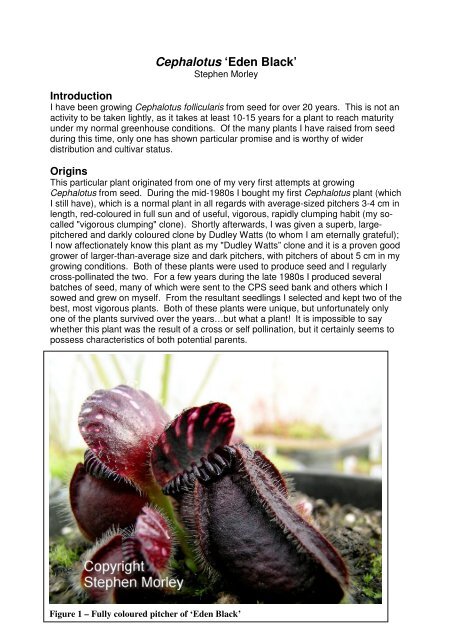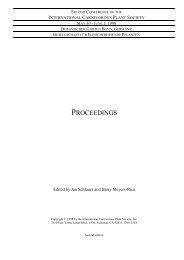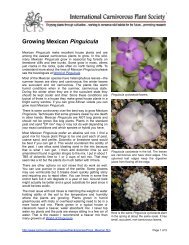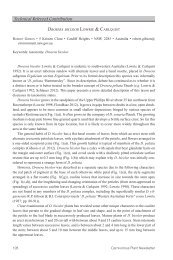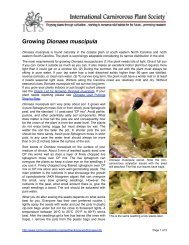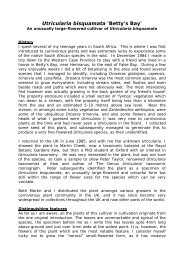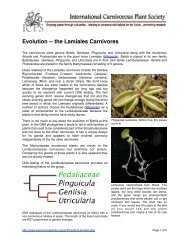Cephalotus 'Eden Black' - International Carnivorous Plant Society
Cephalotus 'Eden Black' - International Carnivorous Plant Society
Cephalotus 'Eden Black' - International Carnivorous Plant Society
Create successful ePaper yourself
Turn your PDF publications into a flip-book with our unique Google optimized e-Paper software.
<strong>Cephalotus</strong> ‘Eden Black’<br />
Stephen Morley<br />
Introduction<br />
I have been growing <strong>Cephalotus</strong> follicularis from seed for over 20 years. This is not an<br />
activity to be taken lightly, as it takes at least 10-15 years for a plant to reach maturity<br />
under my normal greenhouse conditions. Of the many plants I have raised from seed<br />
during this time, only one has shown particular promise and is worthy of wider<br />
distribution and cultivar status.<br />
Origins<br />
This particular plant originated from one of my very first attempts at growing<br />
<strong>Cephalotus</strong> from seed. During the mid-1980s I bought my first <strong>Cephalotus</strong> plant (which<br />
I still have), which is a normal plant in all regards with average-sized pitchers 3-4 cm in<br />
length, red-coloured in full sun and of useful, vigorous, rapidly clumping habit (my socalled<br />
"vigorous clumping" clone). Shortly afterwards, I was given a superb, largepitchered<br />
and darkly coloured clone by Dudley Watts (to whom I am eternally grateful);<br />
I now affectionately know this plant as my "Dudley Watts” clone and it is a proven good<br />
grower of larger-than-average size and dark pitchers, with pitchers of about 5 cm in my<br />
growing conditions. Both of these plants were used to produce seed and I regularly<br />
cross-pollinated the two. For a few years during the late 1980s I produced several<br />
batches of seed, many of which were sent to the CPS seed bank and others which I<br />
sowed and grew on myself. From the resultant seedlings I selected and kept two of the<br />
best, most vigorous plants. Both of these plants were unique, but unfortunately only<br />
one of the plants survived over the years…but what a plant! It is impossible to say<br />
whether this plant was the result of a cross or self pollination, but it certainly seems to<br />
possess characteristics of both potential parents.<br />
Figure 1 – Fully coloured pitcher of ‘Eden Black’
Characteristics<br />
The most notable characteristic of this cultivar is the darkly coloured pitchers. I refer to<br />
them as black, which is possibly what some might call artistic licence, but they are<br />
certainly at least as black as many darkly coloured plants of popular garden plant<br />
species given the same description; they are probably best described as dark purple. I<br />
find it almost impossible to capture accurately the colour in any photograph, although<br />
photos do give an impression of the colour, hence I will refer to colour using standard<br />
colours from the RHS colour chart. To be specific they correspond to the RHS mini<br />
colour chart colour RHS 200A (dark brown) when fully coloured. See Figure 1 which<br />
shows a fully coloured pitcher. In contrast, my "Dudley Watts" clone has pitcher colour<br />
corresponding to RHS 187A (dark purple brown). The peristome of ‘Eden Black’<br />
darkens quickly in full sun and the rest of the pitcher follows suit, with the pitcher<br />
eventually assuming virtually the same colour as the peristome; this is unlike any other<br />
<strong>Cephalotus</strong> I grow, where the pitchers are usually a hue lighter than the peristome.<br />
The dark colour spreads to both the outer and inner surfaces of the lid, even suffusing<br />
the windows with colour. The inner collar of the pitcher also becomes a dull purple<br />
colour in parts.<br />
The pitchers are on the large side, and are at least as big as my "Dudley Watts"<br />
pitchers at 5 cm, although they are getting bigger every year; the plant produced flower<br />
buds in 2005 for the first time, but is possibly not yet fully mature. The pitchers are<br />
elegant, long, relatively smooth and more-or-less straight-sided, lacking very crinkly<br />
pitchers characterising some of the clones available in cultivation. They have a wellformed<br />
peristome and a wide mouth; here they differ from the “Dudley Watts” clone<br />
which is noticeably constricted towards the mouth with a chunky, thickened peristome.<br />
The plant is rather shy in producing non-carnivorous leaves, a trait it shares with my<br />
"vigorous clumping" clone, which is a super characteristic for the grower but not terribly<br />
conducive to propagation from leaf cuttings (non-carnivorous leaves are usually easier<br />
to root)!<br />
This cultivar requires good light to produce optimum colouration and all my plants are<br />
grown in a cool greenhouse receiving full sun all day with no shading, apart from<br />
bubble plastic. Temperatures are in the range of 5 o C-35 o C. I suspect the pitchers may<br />
reach an even darker colour under higher light intensity than I get here in Yorkshire. In<br />
contrast, they would probably be larger but not so highly coloured under shadier<br />
growing conditions. I do not believe that the dark colour is attributable to unique<br />
growing conditions as the plant is grown alongside seven other different clones in<br />
identical pots and compost and these plants never develop the intense dark<br />
colouration. See Figure 2 which shows <strong>'Eden</strong> <strong>Black'</strong> growing alongside my “Dudley<br />
Watts” and "vigorous clumping" <strong>Cephalotus</strong> clones for comparison.
Figure 2 - Comparative photograph with my “Dudley Watts” clone on<br />
the left, normal “vigorous clumping” clone in the middle and ‘Eden<br />
Black’ on the right, all grown in identical pots, growing media and<br />
lighting conditions. Pot size is 13.5cm.<br />
Cultivation<br />
The plant is as easy to grow as any other <strong>Cephalotus</strong>. I grow my plants in a mixture of<br />
approximately 1:1 peat substitute: perlite in relatively deep rose pots. In common with<br />
some dark-coloured Sarracenia clones the intense, dark colour may take a while to<br />
recover following repotting or other stressful incidents. During a rather careless crownlifting<br />
exercise in the spring of 2006 I accidentally split my only plant into several<br />
pieces. Quite fortuitous I suppose, as it lessens the risk of an individual catastrophic<br />
loss. I also managed to root a few pitcher leaves and have distributed some of these<br />
to other growers in Britain and Europe. To preserve the unique characteristics of the<br />
plant it should only be propagated vegetatively via leaf or rhizome cuttings, or by<br />
division.<br />
Etymology<br />
The cultivar is proposed as <strong>Cephalotus</strong> <strong>'Eden</strong> Black’. The name refers both to my<br />
house name as well as the dark colour of the pitchers.<br />
This article was originally printed in The <strong>Carnivorous</strong> <strong>Plant</strong> <strong>Society</strong> Journal 2006 Vol 29


